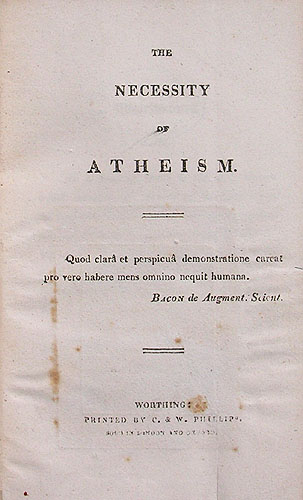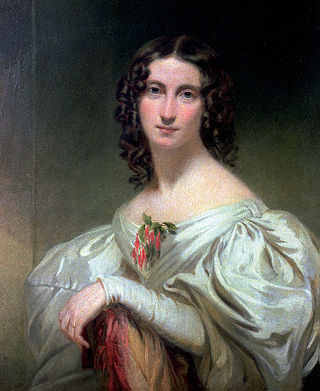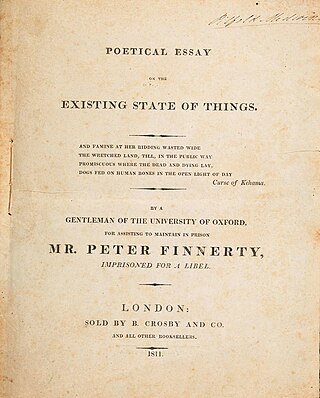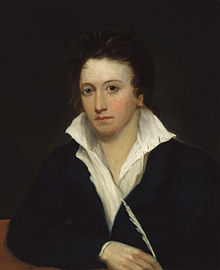This article contains information about the literary events and publications of 1811.
This article contains information about the literary events and publications of 1810.

"The Necessity of Atheism" is an essay on atheism by the English poet Percy Bysshe Shelley, printed in 1811 by Charles and William Phillips in Worthing while Shelley was a student at University College, Oxford.

Edward Dowden was an Irish critic, professor, and poet.

Clara Mary Jane Clairmont, or Claire Clairmont as she was commonly known, was the stepsister of the writer Mary Shelley and the mother of Lord Byron's daughter Allegra. She is thought to be the subject of a poem by Percy Bysshe Shelley.

Thomas Jefferson Hogg was a British barrister and writer best known for his friendship with the Romantic poet Percy Bysshe Shelley. Hogg was raised in County Durham, but spent most of his life in London. He and Shelley became friends while studying at University College, Oxford, and remained close until Shelley's death. During their time at Oxford they collaborated on several literary projects, culminating in their joint expulsion following the publication of an essay titled "The Necessity of Atheism". They remained good friends, but their relationship was sometimes strained because of Hogg's attraction to the women who were romantically involved with Shelley.

Edward John Trelawny was a British biographer, novelist and adventurer who is best known for his friendship with the Romantic poets Percy Bysshe Shelley and Lord Byron. Trelawny was born to a family of modest income but extensive ancestral history. Though his father became wealthy while he was a child, Edward had an antagonistic relationship with him. After an unhappy childhood, he was sent away to a school. He was assigned as a volunteer in the Royal Navy shortly before he turned thirteen.
Nationality words link to articles with information on the nation's poetry or literature.
Nationality words link to articles with information on the nation's poetry or literature.

Percy Bysshe Shelley was an English writer who is considered as one of the major English Romantic poets. A radical in his poetry as well as in his political and social views, Shelley did not achieve fame during his lifetime, but recognition of his achievements in poetry grew steadily following his death, and he became an important influence on subsequent generations of poets, including Robert Browning, Algernon Charles Swinburne, Thomas Hardy, and W. B. Yeats. American literary critic Harold Bloom describes him as "a superb craftsman, a lyric poet without rival, and surely one of the most advanced sceptical intellects ever to write a poem."

James Griffith (1761–1821) was an Oxford academic and administrator. He was elected as a Fellow of University College, Oxford in 1784. From 22 January 1808, he was Master of the College until his death in 1821.

Thomas Medwin was an early 19th-century English writer, poet and translator. He is known chiefly for his biography of his cousin, Percy Bysshe Shelley, and for published recollections of his friend, Lord Byron.

Mary Wollstonecraft Shelley was an English novelist who wrote the Gothic novel Frankenstein; or, The Modern Prometheus (1818), which is considered an early example of science fiction. She also edited and promoted the works of her husband, the Romantic poet and philosopher Percy Bysshe Shelley. Her father was the political philosopher William Godwin and her mother was the philosopher and women's rights advocate Mary Wollstonecraft.

Posthumous Fragments of Margaret Nicholson was a collection of poetry published in November, 1810 by Percy Bysshe Shelley and his friend Thomas Jefferson Hogg while they were students at Oxford University. The pamphlet was subtitled: "Being Poems found amongst the Papers of that Noted Female who attempted the Life of the King in 1786. Edited by John Fitzvictor." The pamphlet was published by John Munday and Henry Slatter in Oxford and consisted of fictional fragments that were in the nature of a hoax and prank or burlesque.

Jane Williams was a British woman best known for her association with the Romantic poet Percy Bysshe Shelley. Jane was raised in England and India, before marrying a naval officer and settling in London. She soon left him for another military officer, Edward Ellerker Williams. After Edward and she left England for Italy, they became acquainted with Percy and Mary Shelley. Though she never had a romantic relationship with Shelley, near the end of his life he became deeply infatuated with her and addressed several of his poems to her. After Shelley and Edward Williams perished in a boating accident, she lived with Thomas Jefferson Hogg, also a close friend of Shelley, and had two children with him. The rest of her life was spent as a housewife in London.

A Vindication of Natural Diet is an 1813 book by Percy Bysshe Shelley on vegetarianism and animal rights. It was first written as part of the notes to Queen Mab, which was privately printed in 1813. Later in the same year the essay was separately published as a pamphlet.
Charles Ollier (1788–1859) was an English publisher and author, associated with the works of Percy Bysshe Shelley and John Keats.

"Poetical Essay on the Existing State of Things" is an essay by Percy Bysshe Shelley published in 1811. The work was lost since its first appearance until a copy was found in 2006 and made available by the Bodleian Library in 2015. The anti-war and anti-imperialist work was intended to raise money for the radical Irish journalist Peter Finnerty, who had been imprisoned for libeling the Anglo-Irish politician Robert Stewart, Viscount Castlereagh, whom he accused of mistreating United Irish prisoners. The work is a precursor to The Masque of Anarchy and "England in 1819".

John Frank Newton was a British vegetarianism activist and Zoroastrian.
Harriet de Boinville (1773–1847) was a British woman who entertained widely in London and Paris. She influenced important writers of her day, including Frances Burney, William Godwin, Percy Bysshe Shelley, Mary Shelley, and Giovanni Ruffini. She welcomed guests of all social classes at her popular salons and befriended destitute refugees. She held progressive views and believed in the benefits of a vegetarian diet.

















